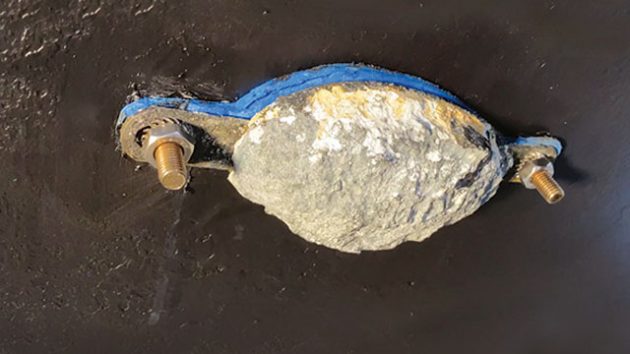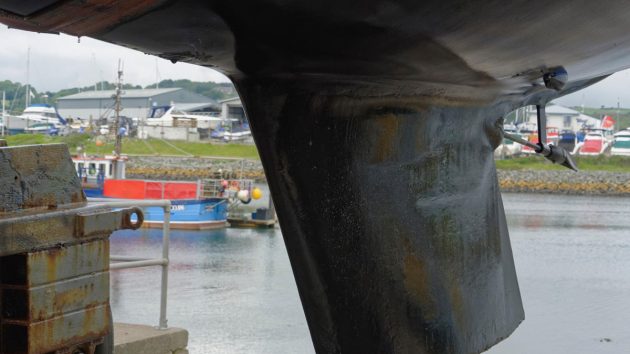Boat owners and boatbuilders across the UK are being urged to switch from zinc to aluminium anodes to help marine life, in addition to the scientific and price benefits.
The call for an industry-standard change follows research by the Clean Harbours Partnership and is supported by PBO’s expert metallurgist and engineer Vyv Cox.
Boat anodes protect underwater metals from galvanic corrosion. If you have two dissimilar metals, such as stainless steel and bronze, the water will act as an electrolyte and the less noble, more reactive of the two metals, the bronze, becomes an anode and will corrode instead of your valuable boat parts.
Sacrificial anodes generally come in three metals: aluminium, magnesium and zinc.

This anode has done its job and is now severely depleted so needs changing
Aluminium anodes should become an industry standard
The Clean Harbours Partnership has been looking at the release of metals, particularly copper and zinc, by recreational vessels into the marine environment, and is now advocating for an industry change because zinc anodes contain cadmium, which is particularly harmful to marine life.
All metals are toxic to marine life, zinc is also harmful and to a lesser extent so is aluminium – it depends on the concentrations.
In 2020, Gordon Watson, Professor of Marine Zoology at the University of Portsmouth, approximately 900 tonnes* of zinc is released into UK coastal and inland waters by recreational vessels in an average year.
“The problem is metals do not degrade. They accumulate in the ocean and in sediment on the sea bed, where organisms at all levels in the food chain ingest them. Zinc anodes also contain cadmium, which is harmful to marine life, whereas aluminium does not,” explains James Collings-Wells of the Clean Harbours Partnership.
“Whilst aluminium anodes are being used by some of the UK’s major boat manufacturers, evidently they are not being used widely enough. We are urging boat builders and boaters across the UK to switch to using aluminium anodes.”
Professor Watson said that in addition to switching from zinc to aluminium, boaters should consider the amount of anodes required: “We think that many boaters have too much – either aluminium or zinc.”

Typical Aluminium anode
Zinc versus aluminium
Chartered engineer Vyv Cox, who has qualifications in both metallurgy and mechanical engineering and is the author of Metals in Boat**, explains why zinc anodes have previously been favoured: “Although aluminium alloy anodes have been in existence for many years they were more expensive than their zinc equivalents, limiting their application.
“The cost of high purity zinc has doubled in the past 10 years according to manufacturer MGDuff, meaning that aluminium anodes are now the cheaper option, in addition to their performance benefits.”
Aluminium alloy is more environmentally friendly (although Prof. Watson caveats that a lot less research has been done on it) and has several advantages over zinc as anode material.
With a higher driving voltage than zinc, it is particularly effective in brackish water; it is lighter; and its higher electrochemical capacity means that the same-sized anode will last longer.
Continues below…
First evidence of GRP boats’ “cancerous” impact on aquatic life
The ‘really worrying’ findings by University of Brighton researchers who undertook studies off the coast of Hampshire and West Sussex…
How to: check and change an anode
Galvanic corrosion is a phenomenon that affects the majority of boats. If you have two dissimilar metals, such as stainless…
Boat anode protection: How much do I need to prevent corrosion?
PBO reader Arthur Gilbert asks: “Is it necessary, and if so where, to fit anodes on my recently acquired Leisure…
Vyv agrees that switching from zinc to aluminium could also have scientific benefits, and possible price benefits: “Whilst the galvanic potentials of zinc and aluminium anodes are very similar, the capacity of the aluminium version is much greater. Thus aluminium anodes are superseding zinc ones in general use, as the benefits are: They may be used in both salt and brackish water; Their higher electrical capacity allows the use of smaller anodes; The alloy remains active if exposed to air and will reactivate when re-immersed.”
He added: “Due to commodity prices, aluminium anodes are now 20% cheaper than their zinc alternatives. At present both are equally priced, so it seems the cost savings are being taken by the manufacturers rather than the consumers, which is a little disappointing. Perhaps it will settle in our favour eventually, particularly if the take-up of aluminium anodes increases due to this Clean Harbours Partnership initiative.”

Anodes from zinc, new and eroded, attached to the hull of a boat as sacrificial metal. Credit: Ron Giling/Alamy
Aluminium sterndrives and hulls?
Aluminium anodes are far less noble than the alloys used for aluminium hulls and saildrives legs and therefore they can be used effectively together.
Vyv said: “Most pure metals are of little use in engineering terms, needing to be alloyed with other metals to provide the desired properties of strength, corrosion resistance, wear resistance, etc.
“Aluminium is commonly alloyed with silicon, magnesium and others for many yacht components such as spars and saildrives in grade 6061 and for hulls in grade 5086.
The galvanic potential of aluminium alloys ranges from about -0.75 to -0.95 volts, with both of these grades towards the lower end of this range, i.e. they are relatively noble.
“Aluminium anodes are precisely manufactured to contain 3.5 – 5.0% zinc and very small amounts of titanium, silicon, bismuth and indium. This gives these anodes a very slightly lower (more anodic) galvanic potential than those in zinc to the specification MIL-A-1800H, the most widely used grade.
“The potential of these two is around -1.01 to -1.02 volts.”

Chartered engineer Vyv Cox, a metallurgy and mechanical engineering expert
Mass replacement
Clean Harbours Partnership advises that when changing from zinc to aluminium alloy, all external anodes should be replaced at the same time. However, this does not apply to zinc anodes in the engine water cooling system, if the two bodies of water are separate.
If an anode is eroding more quickly than expected, it is worth looking for an electrical problem causing stray current. Addressing this would reduce the amount of metal shed by the anodes into the environment. Prolonged connection to shore power without a galvanic isolator can have the same effect.
—
**We may earn a percentage of any sale from this affiliate link but it doesn’t add to the cost or affect our editorial independence.
Zinc figures
* Information to support the statement that “approximately 900 tonnes of zinc is released into UK coastal and inland waters by recreational vessels in an average year” can be found towards the end of 3.6 in the article; the reader is directed to Table 6 in S2 (S stands for supplementary material). You can find that by downloading Supplementary data 2 in Appendix A.
In table 6, you will find a figure for estimated annual zinc release per recreational vessel of 1.66kg. They have actually put 1.66kg/day, which a Clean Harbours spokesman has confirmed is a mistake, it should read per year. This was apparently rectified, but still appears online. The figure of 1.66 comes from Rees et al, 2017, and Boxall et al, 2000. These both appear at the end of the article. Only the abstract of Rees et al can be viewed, since the complete article is behind a paywall. Boxall et al can be read as a PDF.
The authors used 546,818 as the number of registered sailing/recreational vessels in the UK (2018 boating industry survey), then multiplied this figure by 1.66 to arrive at 907 tonnes.
One PBO reader has asked: “How much zinc is naturally occurring, how can they be sure boats are to blame?”
Professor Gordon Watson responds: “The 900 tonnes was calculated for all registered recreational vessels in the UK so, as you can imagine, it is hard to disentangle inputs from boats from other sources (industry, brake pad wear of vehicles etc) and naturally occurring zinc (in rocks/sediment). But what we see for copper used in antifouling paints is a clear signal of contamination in the sediment and in some locations we do see that for zinc too.”







